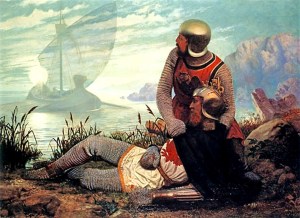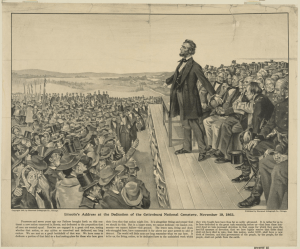We support our Publishers and Content Creators. You can view this story on their website by CLICKING HERE.
Hans Urs von Balthasar believed that tragedies that feature the death of the hero—the sacrificial crisis of the innocent victim—reflect the fullest dramatic meaning of the Passion of Christ: In these stories, good violence is needed in order to make the bad violence go away.
Hans Urs von Balthasar, in Volume IV (The Action) of Theo-Drama, arguably his most innovative theological work, contains a very brief discussion of the work of René Girard. But what von Balthasar says there about Girard, theology, and drama is especially revealing:
“Girard’s is surely the most dramatic project to be undertaken today in the field of soteriology and in theology generally. In his view, world history and all the values realized in it are based on a primal tragedy that has now been disclosed; it comes to a climax—and this is also its turning point—in the tragedy and rejection of Christ.”[1]
The primal tragedy, according to Girard, is the tragedy of the scapegoat. An innocent victim is violently sacrificed by a unanimous mob. In myths, the memory of this event is preserved, but also in myths the scapegoats have become distortedly deified into barely recognizable figures that, no longer the victims, now possess supernatural power to restore peace to a community. Hidden by the myth is the truth that in fact an innocent victim paid the price in order for peace to be achieved by ritual violence.
Balthasar rightly sees the foremost dramatic significance of this primal tragedy for Girard in its relation to the Gospel. Of Girard’s analysis of the role of ritual scapegoating in every culture, Balthasar says:
“Initially, the dramatic element seems to be the primal tragedy that grounds all culture, that is, the scapegoat, profoundly ambivalent, which is epitomized in the case of Christ. But, at a deeper level, we see that the real drama lies in the effect this epitome [viz., Christ as scapegoat] has: it revolutionizes and unmasks everything that follows it. Nietzsche’s antithesis—Dionysus versus the Crucified—is correct, but only in its reverse form: the Crucified versus Dionysus. ”[2]
In his “Attempt at a Self-Criticism” (1886), prefaced to The Birth of Tragedy, Nietzsche asks, “What is Dionysiac?”[3] Nietzsche explains his this-worldly opposition to the otherworldly Christian “hostility to life” in The Birth of Tragedy this way, as the answer to the question, “What is Dionysiac?”:
“So then, with this questionable book, my instinct, an affirmative instinct for life, turned against morality and invented a fundamentally opposite doctrine and valuation of life, purely artistic and anti-Christian. What should I call it? As a philologist and man of letters, I baptized it, not without a degree of license–for who knows the true name of the Antichrist?–with the name of a Greek god: I called it the Dionysiac.”[4]
It is true that a profound appreciation of Nietzsche informs René Girard’s mimetic theory.[5] Girard has said provocatively that his main discovery does not in fact originate with himself; it comes rather from his reading of Nietzsche.[6] On his attention to sacrificial themes in literature, Girard insists that “this reading is not mine first of all, it is Nietzsche’s. Nietzsche was the first thinker to see clearly that the singularity of Judeo-Christianity was that it rehabilitates victims that myths would regard as justly immolated.”[7]
The difference is that Nietzsche’s agonistic thinking relishes the prospect of violence and sacrificial victims.[8] The Girardian conception of mimesis, however, debunks mythology (whether in its ancient forms, or in its modern psychoanalytic versions; e.g., the story of Oedipus) by using the insights of tragedy. In this way, his mimetic theory both incorporates Nietzsche’s profound insights into tragedy’s violence, and yet also advances beyond him. Girard’s Christian reversal of Nietzsche is to repudiate, not to celebrate, the scapegoat mechanism: i.e., that social mechanism, employed by victimizers, to blame and persecute their victims.
The weakest point in Girard’s work, from the standpoint of the Catholic tradition, was also identified in Theo-Drama Volume IV by Balthasar:[9] There seems to be no room for natural theology in Girard’s theory, because human consciousness is foundationally enslaved to the bad mimesis of the scapegoating mechanism.[10] In other words, the dignity and integrity of human reason is compromised because of Girard’s emphasis on the dark origin of consciousness in the evolutionary process controlled by the scapegoating mechanism. Girard’s response to this apparent weakness in his theory has been to emphasize, in the latter phase of his career, the possibility of a type of good mimesis.[11]
Girard’s solution, however, identifies the source of good mimesis as purely divine in origin. The dignity of human reason on its own, therefore, seems to remain somewhat compromised, and the best correction of the Girardian hypothesis on this point would perhaps be for metaphysicians as well as theologians to engage with Girard’s pioneering work. Moreover, if evolutionary biology were to fruitfully engage with Girard’s ideas, then perhaps natural theology could, with the cooperation of the natural sciences, find the most appropriate bridge via nature to Girard’s dramatic re-presentation of fundamental theological truths.
Yet even so, perhaps Girard has pursued the most fruitful approach for the long run with his dogged emphasis on literary interpretation. Perhaps the most revealing links to the threads of humanity’s natural dignity, to be found throughout humanity’s dark history right alongside the scapegoating mechanism, will be found by the most intrepid literary explorers. A particularly exciting indication of this possibility may be found in Girard’s admission that “my preceding interpretation of Greek civilization did not do the Greeks justice.”
Girard made this admission after Balthasar’s published assessment, and he wrote it in his preface to Giuseppi Fornari’s book, Between Dionysus and Christ: Sacrifice, Greek Wisdom, and Western Civilization. Girard describes how Fornari’s work on Dionysus convinced him of how the Greeks demonstrate that the scapegoat mechanism has not resulted in a total eclipse of natural, good mimesis in history:
“Fornari, speaking eloquently between the lines with constant allusions to Nietzsche, documents how Dionysus corresponds in Greece to the reality that the Gospels call Satan. Yet, at the same time, he shows that behind Dionysus we must recognize and understand the effort on the part of ancient man to save himself from violence, by applying his intelligence and creativity in a limited but real contact with the transcendent.”[12]
In other words, although knowledge of the innocent victim actually resides in the Gospel texts (with their repudiation of the scapegoat mechanism), it does not reside there exclusively. Potentially, in intimations, it also lies elsewhere; for example, in Greek tragedy. To find it in Greek tragedy, we need only to read the intimations there of human dissatisfaction with the whole process of violence as it comes to human consciousness in literary reflection: a tragedy has an unhappy (or serious) ending, not a happy (or comic) one, a fact with which we must forthrightly deal.
Girard has emphasized how, in drama, tragedy is able to portray the violent crisis point—the point of no return—of the mimetic process. This very crisis is what Girard calls the sacrificial crisis.[13] Once it is reached, the standard violent practices do not work anymore. They break down. A new kind of violence is required. For there will be no end to the sacrificial crisis unless a new violence can be found and made to work.
Typically, in tragedy, such a renovation is achieved by the dramatic death of the hero. The story of the sacrificial crisis is, in brief, expressed by this ancient myth: Good violence suddenly becomes bad violence; good violence is needed again, in order to make the bad violence go away. If, then, the sacrificial crisis is good violence that has gone bad, the only apparent solution to the crisis is to find a substitute victim. The victim of the bad violence (the good violence gone bad) is replaced with the victim of good violence, so that sacrifice can once again be affirmed and violence can work to bring peace: we must admit a little disorder (sacrifice of a scapegoat) to avoid widespread chaos (the sacrificial crisis).[14]
It is a dramatically powerful insight, and one that Balthasar rightly recognizes in Girard as tremendously significant for theology. For it is nothing less that the fullest dramatic meaning of the Passion, a drama that extends its revelatory power to every moment in history.
This essay was first published here in September 2015.
The Imaginative Conservative applies the principle of appreciation to the discussion of culture and politics—we approach dialogue with magnanimity rather than with mere civility. Will you help us remain a refreshing oasis in the increasingly contentious arena of modern discourse? Please consider donating now.
Notes:
[1] Hans Urs von Balthasar, Theo-Drama: Theological Dramatic Theory, Vol. IV: The Action (San Francisco: Ignatius Press, 1994), 299.
[2] Balthasar, Theo-Drama IV, 300.
[3] Nietzsche, “Attempt at a Self-Criticism” (sections 3-4); translation by Shaun Whiteside (Penguin, 1993).
[4] Nietzsche, “Attempt at a Self-Criticism,” 9 (section 5).
[5] Cf. René Girard, “The Founding Murder in the Philosophy of Nietzsche,” in Paul Dumouchel (ed.), Violence and Truth: On the Work of René Girard (London: Athlone Press, 1988) 227–246; “Nietzsche and Contradiction,” Stanford Italian Review 6,1-2 (1986) 53–65; “Dionysus Versus the Crucified,” Modern Language Notes 99,4 (1984) 816–835; “Superman in the Underground: Strategies of Madness—Nietzsche, Wagner and Dostojevsky,” Modern Language Notes 91 (1976): 1161–1185.
[6] René Girard, “The Scapegoat: René Girard’s Anthropology of Violence and Religion,” (CBC: Ideas Transcript, 5–9 March 2001), 45.
[7] René Girard in The Girard Reader (New York: Crossroad, 1996), 272. Girard goes on to say, “Of course for Nietzsche this was a dreadful mistake that first Judaism, then Christianity had inflicted on the world. Nietzsche chose violence rather than peace, he chose the texts that mistook the victim for a culprit. What he could not see was the scapegoat mechanism.”
[8] Cf. “Homer on Competition” (1872) in Keith Ansell-Pearson (ed.) and Carol Diethe (tr.), Nietzsche: On the Genealogy of Morality (Cambridge UP, 1994) 187–194.
[9] Balthasar, Theo-Drama IV, 297–310.
[10] Balthasar, Theo-Drama IV, 308–309.
[11] Cf. Girard, “The Goodness of Mimetic Desire”, in The Girard Reader, 62–65.
[12] Translated by C. S. Morrissey and Paul Faraone from Giuseppe Fornari, Fra Dioniso e Cristo. La sapienza sacrificale greca e la civilta occidentale (Bologna: Pitagora Editrice, 2001).
[13] Cf. Violence and the Sacred, 39-67 (Chapter Two, “The Sacrificial Crisis”).
[14] Cf. “Generative Scapegoating,” in Robert G. Hamerton-Kelly (ed.), Violent Origins: Walter Burkert, René Girard, and Jonathan Z. Smith on Ritual Killing and Cultural Formation (Stanford University Press, 1987), 73–105.
The featured image is “Death of a Hero” (1888), by Nils Forsberg, and is in the public domain, courtesy of Wikimedia Commons. It has been enhanced for clarity.

 Conservative
Conservative  Search
Search Trending
Trending Current News
Current News 





